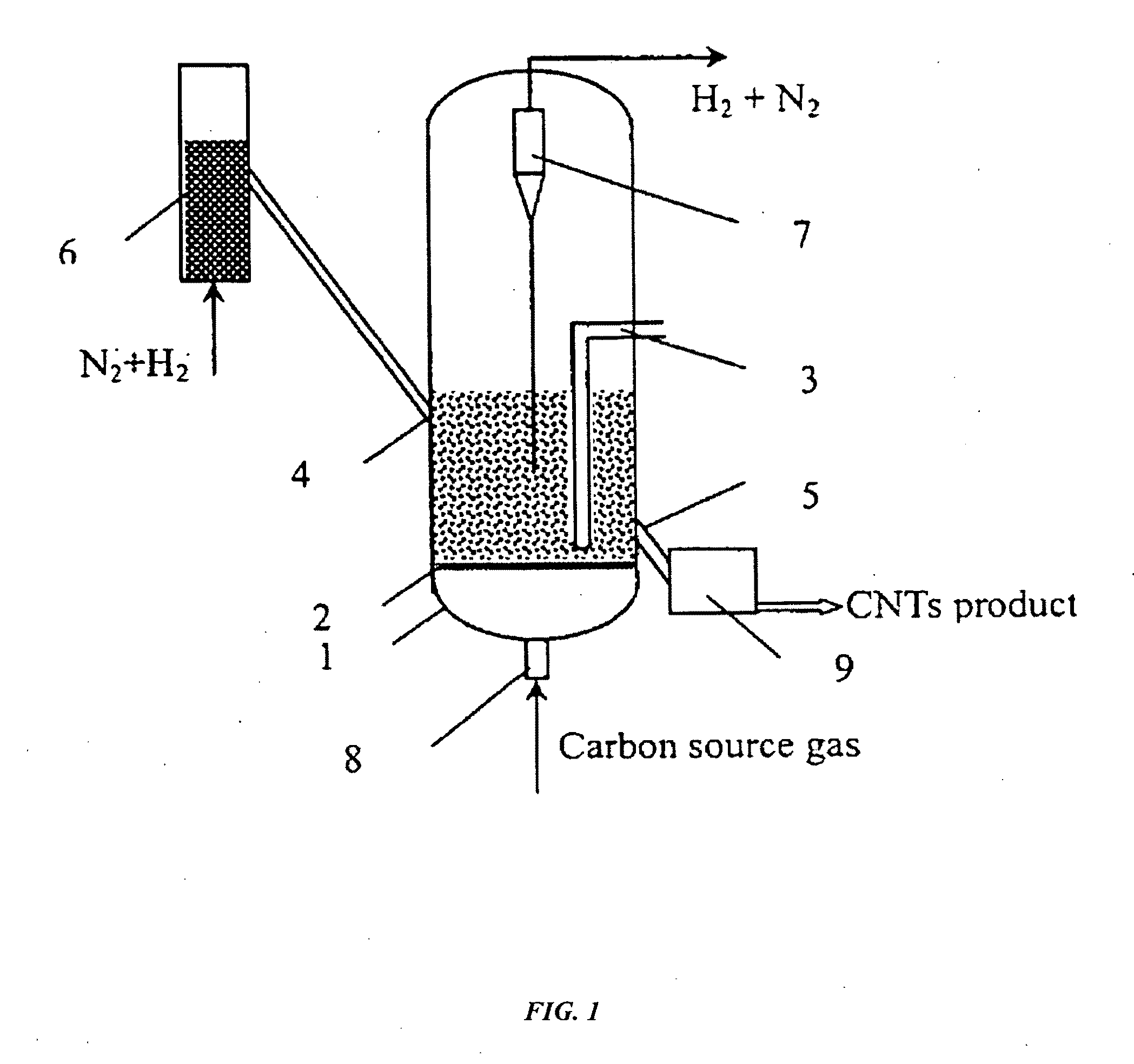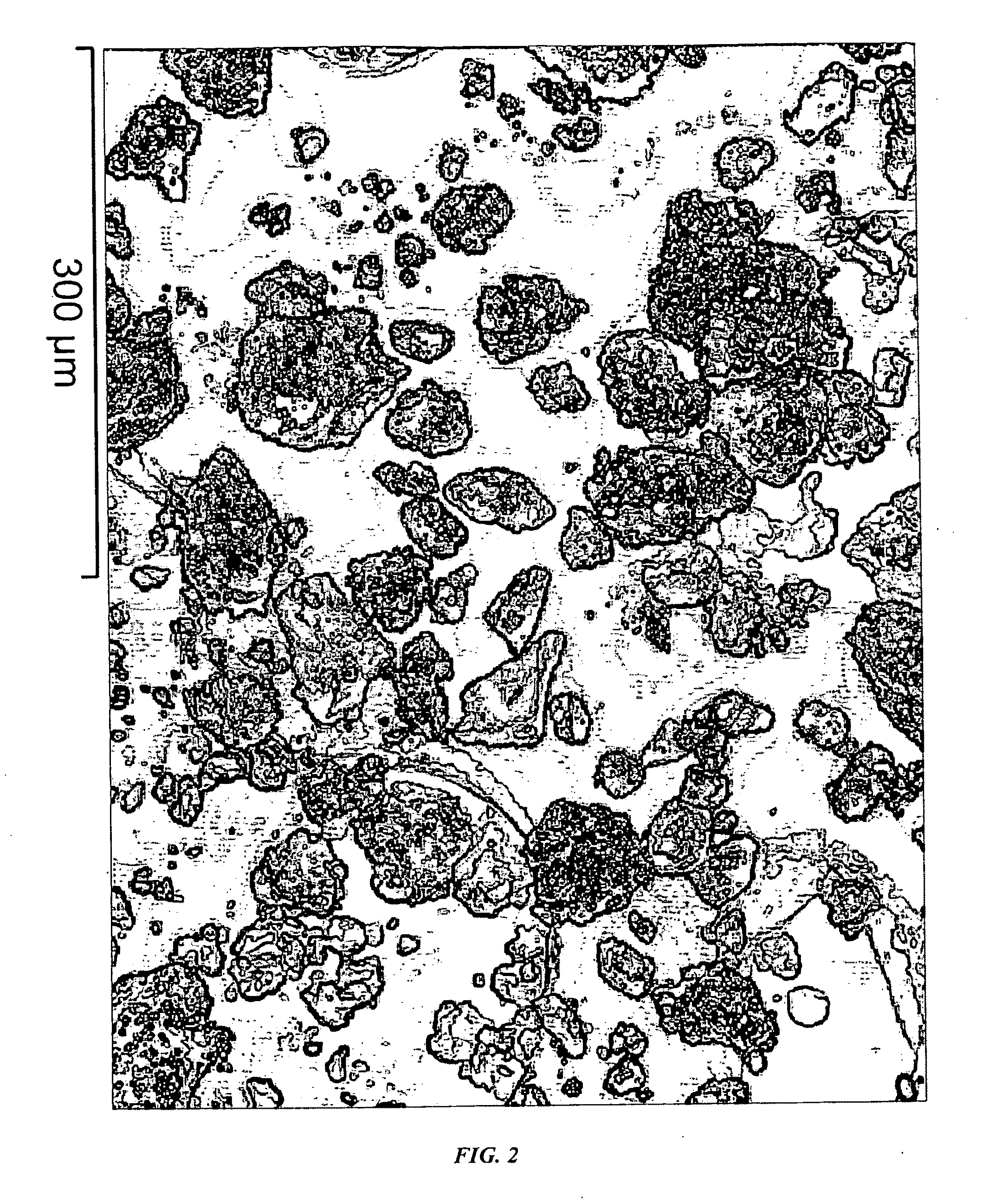Continuous mass production of carbon nanotubes in a nano-agglomerate fluidized-bed and the reactor
a technology of carbon nanotubes and fluidized beds, applied in the direction of physical/chemical process catalysts, metal/metal-oxide/metal-hydroxide catalysts, chemistry apparatuses and processes, etc., can solve the problems of high production cost, mass production of carbon nanotubes, and commercial application that has not been realized, and achieve excellent adaptability of the reactor system
- Summary
- Abstract
- Description
- Claims
- Application Information
AI Technical Summary
Benefits of technology
Problems solved by technology
Method used
Image
Examples
example 1
[0036]1. Loading Fe—Cu transition metal oxides on a SiO2 support.
[0037]2. Adding the above supported catalyst into the catalyst activation reactor and carrying out the reduction reaction by flowing a mixture of hydrogen and nitrogen into the reactor at 650° C., wherein the volume ratio of hydrogen to nitrogen was 1:0.5 and the space velocity of the reduction reaction was 0.5 h−1.
[0038]3. Transporting the reduced catalyst into the fluidized bed with temperature at 700° C., feeding a mixture of hydrogen, ethylene and nitrogen into the reactor, wherein the volume ratio of H2:C2H4:N2 was 1:1:1 and the space velocity during the reaction was kept at 10000 h−1 and the superficial gas velocity was 0.5 m / s.
[0039]FIG. 2 shows a typical SEM photo of the carbon nanotubes produced in the example 1. The sample was directly obtained from the reactor and was not subjected to any purification nor pulverization. The carbon nanotubes are in the form of agglomerates, and most of the agglomerates are ne...
example 2
[0042]1. Loading Ni—Cu transition metal oxides on a glass bead support.
[0043]2. Adding the above supported catalyst into the catalyst activation reactor and carrying out the reduction reaction by flowing a mixture of hydrogen and nitrogen into the reactor at 520° C., wherein the volume ratio of hydrogen to nitrogen was 1:1 and the space velocity of the reduction reaction was 2 h−1.
[0044]3. Transporting the reduced catalyst into the fluidized bed with temperature at 520° C., feeding a mixture of hydrogen, propylene and nitrogen into the reactor, wherein the volume ratio of H2:C3H6:N2 is 1:1:1 and the space velocity during the reaction was kept at 5 h−1 and the superficial gas velocity was 0.09 m / s.
example 3
[0045]1. Loading Co—Mn transition metal oxides on a Al2O3 support.
[0046]2. Adding the above supported catalyst into the catalyst activation reactor and carrying out the reduction reaction by flowing a mixture of hydrogen and nitrogen into the reactor at 800° C., wherein the volume ratio of hydrogen to nitrogen was 1:0.5 and the space velocity of the reduction reaction was 0.3 h−1.
[0047]3. Transporting the reduced catalyst into the fluidized bed with temperature at 870° C., feeding a mixture of hydrogen, methane and nitrogen into the reactor, wherein the volume ratio of H2:CH4:N2 was 0.5:1:0.1 and the space velocity during the reaction was kept at 5000 h−1, and the superficial gas velocity was 0.8 m / s.
PUM
| Property | Measurement | Unit |
|---|---|---|
| Length | aaaaa | aaaaa |
| Length | aaaaa | aaaaa |
| Length | aaaaa | aaaaa |
Abstract
Description
Claims
Application Information
 Login to View More
Login to View More - R&D
- Intellectual Property
- Life Sciences
- Materials
- Tech Scout
- Unparalleled Data Quality
- Higher Quality Content
- 60% Fewer Hallucinations
Browse by: Latest US Patents, China's latest patents, Technical Efficacy Thesaurus, Application Domain, Technology Topic, Popular Technical Reports.
© 2025 PatSnap. All rights reserved.Legal|Privacy policy|Modern Slavery Act Transparency Statement|Sitemap|About US| Contact US: help@patsnap.com



